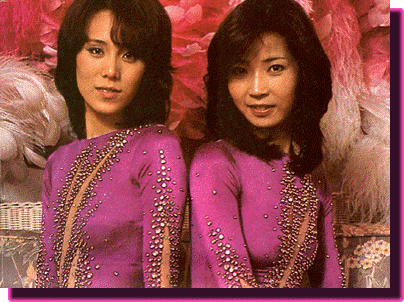KISS IN THE DARK: A HISTORICAL RETROSPECTIVE
by Jeffrey C. Branch
April 1979. I was four months removed from having been stationed in Japan and the wonderful time I had there when I found out, quite by accident, about something incredible after idly reading an item in an issue of Billboard: Pink Lady was about to release their first English language single in the U.S. called “Kiss in the Dark” (to be referred to from here on out as “KITD”).
Needless to say, I was positively shocked to have heard about this, something I had no idea about, so it was quite literally a bolt from the blue to read that Mie and Kei were attempting to make a splash in the American music market. Of course, I was giddy and delighted beyond words at the news and couldn’t wait to get my greedy mitts on the single. One month later, the sun came out, birds chirped happily and choirs sang hosannas as I found the single. Even after twenty-five years, I can easily remember how ecstatic I was when I first saw it: Mie and Kei, attractive as ever, sweetly smiling and wearing what looked like white furs on the cover against a dark blue background with their familiar logo over their heads in----what else----pink. I couldn’t wait to get it home and listen to Pink Lady----in English!
Now don’t get me wrong, I’ve heard Mie and Kei sing in English before the release of KITD, mainly on their live shows like the Las Vegas concert and the famous Jumping Summer Carnival, but this would be entirely different, this time, the girls would be singing for an American audience. My heart was in my throat as I gingerly put the vinyl on my turntable and let ‘er rip. I grinned from ear to ear when I heard Mie and Kei cut loose with a saucy, fast paced, foot tapping Disco tune which I thought sounded really great and had a kicking beat to it, and their English was downright flawless. The B-side, a remake of Left Banke’s “Walk Away Renee” was nice and sweet, a perfect complement to KITD. I was in seventh heaven, extremely pleased with what I heard, and I hoped it would do well in the U.S. market.
At the same time, there were signs that Mie and Kei were starting to achieve that measure of popularity KITD could bring. Not long after I bought the single, the girls appeared on the nationally televised Leif Garrett Special on CBS (which I never saw until somebody sent me a tape of it in 2002) and performed KITD. Since Leif was one of the hottest young stars of the day, his special was seen by millions of teenage girls, and when they saw Mie and Kei, they were quickly fascinated by them. After all, two young, pretty and talented Japanese singers made for quite an entertaining novelty, and American teens fell for the girls like crazy. Teen magazines had features on Pink Lady while letters from kids wanted to know more about Mie and Kei, some even wanted to write to the girls! The ball was now officially rolling.
One month later, the sun, birds and choirs returned full force when KITD debuted on the Billboard Top 100 listing at 94 on June 2nd. Almost immediately, mentions were made about Pink Lady being the first Japanese act to break into the Billboard charts since Kyu Sakamoto reached number one with “Sukiyaki” in 1963. Even though Mie and Kei were, at the time, the top female recording act in the world, that distinction meant absolutely nothing to American music fans as they were completely unknown here. If KITD were to make it’s way up the charts, maybe even reach the top spot, Mie and Kei could become a household name in the U.S., or, at the very least, gain their allotted fifteen minutes of fame, given how easy Disco songs were topping the charts throughout the late 1970’s.
In the second week of June, I checked the Billboard charts and was shocked to see that KITD had rocketed from 94th to 63rd. My first thought when I saw that was: ‘Whoa! This is getting serious!’ While I was getting way ahead of myself, especially since the song was a long way from the top spot, I couldn’t help but wonder if lightning was about to strike twice. A week later, the impossible was one step closer to becoming reality when KITD cracked the Billboard Top 40, checking in at 37! But an even greater honor followed when I heard the song on Casey Kasem’s legendary radio show. That made me proud and happy beyond belief. I can only imagine how elated Mie, Kei and their fans in Japan must’ve felt at the news. By all accounts, it appeared that Pink Lady was about to achieve truly international fame.
And then, the party suddenly came crashing to a halt. When I checked the Billboard charts a week later to see where the song was, I was startled to see KITD wasn’t in the top 40, then stunned to discover it wasn’t even in the top 100, the song was literally there one week and gone the next. That came as a crushing blow to me since I had such high hopes about how high the song could go, and now those dreams were dead. It took a good couple of weeks to get over the disappointment of KITD having dropped off the face of the Earth, once I did, curiosity set in and I asked the question that had been on my mind since the song vanished from the charts: what happened? It would take quite some time to learn the answer, twenty years to be precise, but I figured it out. Pink Lady was the victim of bad timing.
Like I had written on the Pink Music page, the timing of the release of KITD was suspect. We’re talking about a pure Disco song hitting the charts at a time when the genre was petering out, mainly as an act of revolt from music fans who were fed up with the sound that had dominated the latter half of the 70’s. At the same time, the punk sound of Blondie and the power pop of The Cars was taking over as the music of choice while Disco was being shown the door. With the likes of the Bee Gees, Donna Summer and the Village People overexposed, it was a bad time for Pink Lady to debut a Disco song. I’ve said this before, and I’ll go to my grave believing this, if KITD had been released a year, or even six months earlier than it had, the song would’ve done better than it did, it might even have reached number one.
All the elements for success were there. The song was perfect for the Disco genre, teenagers liked it, plus the novelty factor of two Japanese singers streaking up the charts drew people in. Had the timing been better, Mie and Kei could well have struck it rich in the U.S., and once you’ve become famous in the States, you were set for the big time. And with MTV two years away at the time, a high energy song and dance act like Pink Lady would’ve been tailor made for the channel, especially since Mie and Kei were shaking their groove thing on TV screens long before Madonna, Paula Abdul and Janet Jackson. It was entirely possible that Pink Lady could’ve been THE big thing in Japan AND America in the early 1980’s!
Instead, it all went to hell because of the aforementioned miserable timing. The fact that KITD reached into the top 40 a mere two weeks after it’s debut, and did so at a time when Disco was on life support proved that the song had what it took to be number one with a bullet. Unfortunately, it faded into obscurity here; followed by the girls a year later after co-hosting the train wreck that was Pink Lady & Jeff. To this day, it frustrates me no end that Mie and Kei came thisclose to international fame with KITD, only to fall painfully short. Even more agonizing was that the girls never took a second shot at the U.S. market, though given the circumstances, perhaps the girls, burned twice in their goal to become popular in America probably figured a third attempt wasn’t worth the trouble.
In the end, the important thing to note here is that Mie and Kei tried, something no Japanese singer has done since, though some have argued that KITD, followed by the horrendous TV show effectively killed any chance Japanese pop stars had of being taken seriously here. Still, as the old saying goes: getting there is half the fun, and I’m sure Mie and Kei probably had the time of their lives during the journey. Even though the story of “Kiss in the Dark” didn’t have a happy ending, we loved being on the road the girls took us on. In an article I have in my scrapbook, they called their attempt to break into the U.S. music market ‘an adventure’, and, in a way, it certainly was that. An adventure both Mie and Kei, and us, their loyal fans thoroughly enjoyed.

